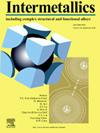W增强激光熔覆CoCrNi中熵合金的显微组织与性能
IF 4.8
2区 材料科学
Q2 CHEMISTRY, PHYSICAL
引用次数: 0
摘要
为了探索W元素对激光熔覆CoCrNi中熵合金组织性能的调控机制,在AISI 1045钢基体上制备了W含量梯度变化的CoCrNiWx (x = 0、0.15、0.3、0.45、0.6)中熵合金涂层。涂层的微观结构表明,当x = 0时,涂层呈现单一FCC固溶体结构。当x >;0、μ相的金属间化合物在镀层中析出,形成FCC + μ相的双相结构。显微硬度测试表明,随着W含量的增加,CoCrNiWx涂层的显微硬度呈上升趋势。其中,W0.6涂层的平均显微硬度最高,达到351.59 HV0.5,是W0涂层的1.84倍。w的加入显著提高了涂层的耐磨性,平均摩擦系数从0.774降低到0.598,磨损体积从0.0673减小到0.0237 mm3。磨损机理主要有粘着磨损、磨粒磨损,并伴有氧化磨损。在3.5 wt% NaCl溶液中进行的电化学测试表明,W0.6具有最高的自腐蚀电位(- 0.460 V)和最低的自腐蚀电流(7.245 × 10 - 7 a /cm2),在电解质中表现出最佳的钝化行为。研究结果为开发综合性能优良的中熵合金涂层提供了参考。本文章由计算机程序翻译,如有差异,请以英文原文为准。

Enhanced microstructure and properties of laser cladding CoCrNi medium-entropy alloy reinforced with W
To explore the regulatory mechanism of the W element on the microstructure properties of laser cladding CoCrNi medium-entropy alloy, CoCrNiWx (x = 0, 0.15, 0.3, 0.45, 0.6) medium-entropy alloy coatings with a gradient change in W content were fabricated on an AISI 1045 steel substrate. The microstructure of the coating shows that when x = 0, the coating presents a single FCC solid solution structure. When x > 0, μ phase intermetallic compounds precipitated in the coating, forming a biphase structure of FCC + μ phase. Microhardness testing revealed an upward trend in the microhardness of the CoCrNiWx coatings with increasing W content. Specifically, the W0.6 coating has the highest average microhardness, attaining 351.59 HV0.5, which is 1.84 times that of the W0 coating. The wear resistance of the coatings is significantly improved with the addition of W. The average friction coefficient decreases from 0.774 to 0.598, and the wear volume reduces from 0.0673 to 0.0237 mm3. The wear mechanisms mainly include adhesive wear, abrasive wear, accompanied by oxidative wear. Electrochemical tests conducted in a 3.5 wt% NaCl solution demonstrated that W0.6 has the highest self-corrosion potential (−0.460 V) and the lowest self-corrosion current (7.245 × 10−7 A/cm2), displaying optimal passivation behavior in the electrolyte. The research results provide a reference for the development of medium-entropy alloy coatings with excellent comprehensive properties.
求助全文
通过发布文献求助,成功后即可免费获取论文全文。
去求助
来源期刊

Intermetallics
工程技术-材料科学:综合
CiteScore
7.80
自引率
9.10%
发文量
291
审稿时长
37 days
期刊介绍:
This journal is a platform for publishing innovative research and overviews for advancing our understanding of the structure, property, and functionality of complex metallic alloys, including intermetallics, metallic glasses, and high entropy alloys.
The journal reports the science and engineering of metallic materials in the following aspects:
Theories and experiments which address the relationship between property and structure in all length scales.
Physical modeling and numerical simulations which provide a comprehensive understanding of experimental observations.
Stimulated methodologies to characterize the structure and chemistry of materials that correlate the properties.
Technological applications resulting from the understanding of property-structure relationship in materials.
Novel and cutting-edge results warranting rapid communication.
The journal also publishes special issues on selected topics and overviews by invitation only.
 求助内容:
求助内容: 应助结果提醒方式:
应助结果提醒方式:


